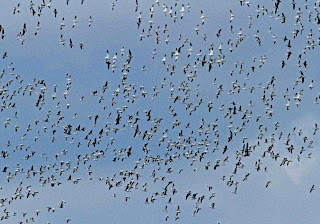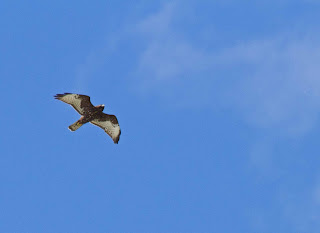The drizzle and wet-cold
have not cleared. The cold was forecast;
the rain is staying a bit longer than expected.
But that is not unusual for the gulf coast; cold fronts tend to stall
and stick around when rain is involved.
But this forty-two-degree drizzle is our January-bad-day
weather, not the usual for a November week.
Ignoring the rain, I bundled
up today and went out; but not in a positive direction. After spending way too many days searching
Petfinder for dog listings, I got up my courage and drove to a not-too-distant
pet shelter. It was in a small town, in
an area a bit off the beaten path, at least for me.
I parked in the small
parking lot, looked and listened, and almost turned around and left. I could hear the barking and the crying out
of dogs, even with windows up and rain tapping on the glass. I sat in my car and noted the barbed-wire
prison-type fencing between the parking lot and the shelter’s small building. The barking and fencing were enough to turn
this birder into a chicken. But I found
a bit of courage, went through the chain link gate, and found the side entrance
door.
I’d called ahead this
morning but gotten little additional info about this particular Petfinder dog. She was described online as a Catahoula
Leopard mix and listed at fifty pounds. I
was concerned about the weight, but the personality description brought me
calling. The web description was of a
gentle dog, that didn’t like the excitement of dog parks, but loved long walks,
and walked well on a leash. That sounded
promising. The breed info described a sturdy dog that should easily hike with
me in all types of terrains.
I won’t go into the details,
but what met me inside a closed-door room was easily an eighty-pound dog that a
very large man was having trouble controlling.
Per doggy research, I ignored the dog (once I knew the man had her on a
strong, tight leash).
I stood tall and confident
and relaxed (I think) and slowly chatted with the man as this HUGE muscular dog
kept jumping on him, chest height. The
jumps were about as playful as a boxer throwing a punch in the ring. I stood back; the dog finally quieted.
Per dog-rescue research, I
slowly and confidently (I think) put the back of my hand out toward the dog so
that she could take a smell. She did,
and for just an instant I thought, yes, this part is going OK.
And then within another
second, she leaped at me and let out a massive bark that sounded out: Attack!
My hand jumped back to my side and the man pulled hard on the dog. The following moment of silence, by all three
of us, was more than awkward.
And then it was the man that
started talking. He wanted me to look at
another dog that he said was calmer, although “a good bit heavier” than this
one. I said thanks, but no thanks, with
the friendliest smile I could muster. I
exited stage right with the dog barking and pulling hard toward me.
I felt overwhelmingly sad
for this dog; and overwhelmingly frustrated at what I’ll call a misleading
description, by web and by phone call. I saw firsthand why this beautiful beast
had been in a shelter over a year.
But I was not the one to save her.
If I owned a working ranch,
with horses and a big pickup truck, and Hoss from Bonanza as my ranch manager,
this dog might have made her escape. But instead, I can only make the
understatement of the year: this dog was
too much for me and they surely knew that when I described what I was looking
for, by phone.
In stark contrast, three
weeks ago I almost came home with a retired greyhound. I’ve been around a few greyhounds; enough to
know how much I love these gentle giants.
With serious intent this fall, I began the extended retired-greyhound
adoption process. Multiple phone interviews with the adoption agency were
followed by their scheduling an appointment with me for a meet-and-greet.
With this scheduled
appointment and a “cleared to take one home”, the adoption agency
representative finally answered the question I’d been asking from the
beginning: Will a greyhound enjoy an hour daily walk? Will a greyhound enjoy a five mile hike on
hill country and similar trails?
The answer was not what I
was expecting. I was told that there was
NO WAY a greyhound would walk for an hour, daily or otherwise. I was told a greyhound could not hike hill-country trails that include pebbles, rocks and crushed granite texture. I cancelled my “cleared to take one home”
appointment. I was surprised at how sad
I felt, and how quickly my tears came.
And what happened
today? I was reminded how much I love
greyhounds. After this miserable day, I’m
ready to hibernate and not reflect any more on today’s experience.
But why can’t a greyhound walk for an hour?














































